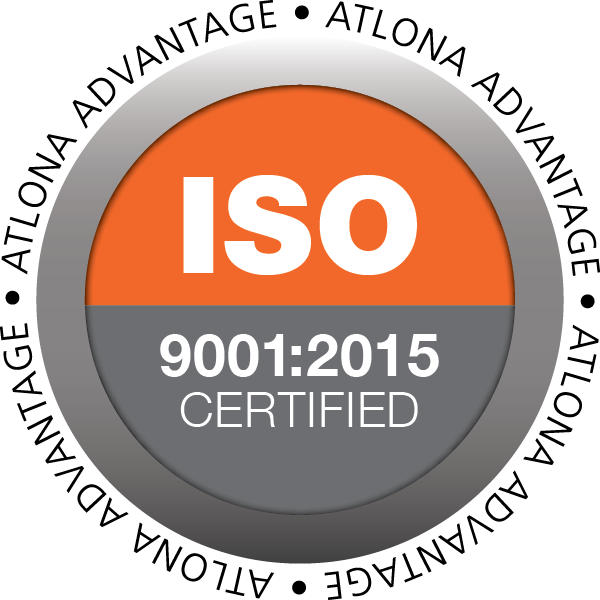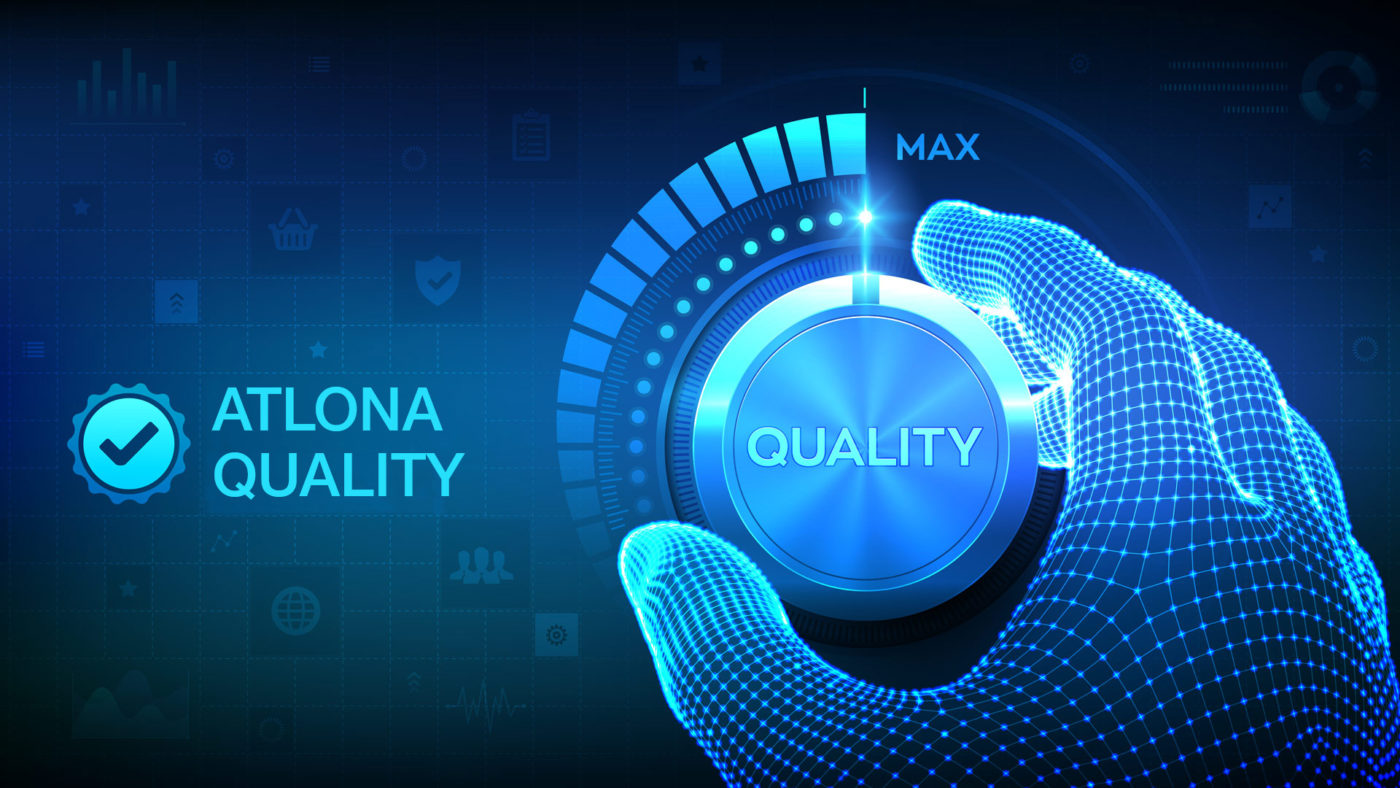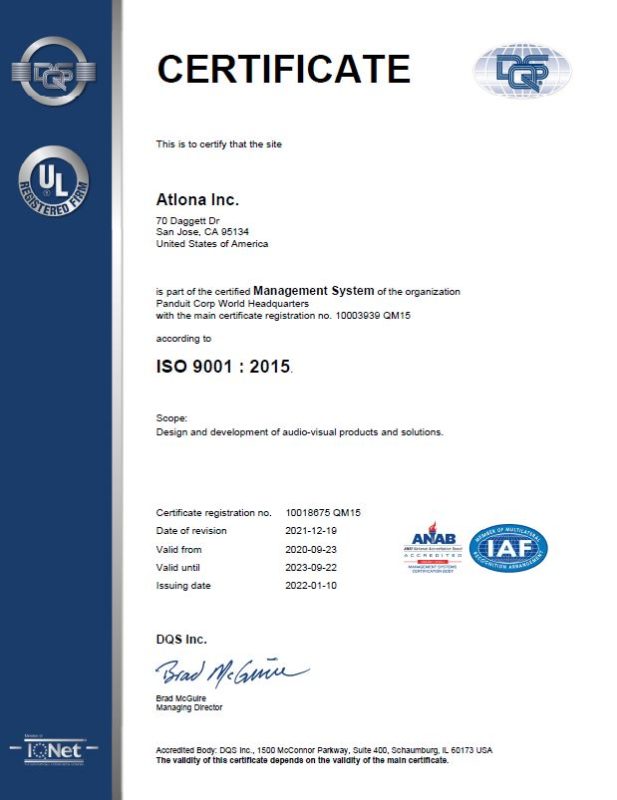As a Panduit company, Atlona is held to the strict quality assurance standards that are applied throughout the entire organization. Ensuring that we are delivering the highest quality solutions possible––and that we are improving upon them continuously––is the responsibility of every employee.
In November 2021, Atlona’s headquarters in San Jose, California (which house research, development and product testing laboratories, as well as client-facing and back office operations) received ISO 9001:2015 certification. This achievement further underlines the company’s dedication to the ongoing delivery of technological excellence. It also illustrates our unflinching commitment to the advancement of the processes involved in building and testing products, addressing the needs of our customers, maintaining solid relationships with our partners, and holding our suppliers accountable.
Developed by the International Organization for Standardization in Geneva, Switzerland, the ISO 9001:2015 certification is the most recent iteration of ISO 9001 (the last update to ISO 9001 having been issued in 2008). It comprises seven Quality Management Principles (QMPs):
Customer Focus
The goal driving any solid quality assurance program is to not just meet the needs of our customers, but to exceed them. Every exchange with a customer, no matter how small, should be viewed as an occasion to provide value by gaining an understanding of their current requirements, and to help them define what future needs may be. This applies to the moment they open product packaging, all the way through deployment and well beyond. To give customers the best experience, we need to ensure that our customer focus-driven processes result in products that meet their use cases, and that perform flawlessly.
Leadership
Without support from the highest levels of company leadership, a quality assurance program will not succeed. At Atlona, our executive management is the uniting body that continually reinforces the application of these quality management principles. Through regular review of the company’s progress, it is they who drive a culture in which quality assurance is the highest priority. It is also these individuals who have the authority to provide the resources and talent required for a successful quality assurance operation to continue to grow.
Engagement of People
As mentioned above, quality assurance is everyone’s responsibility. As director of quality and support, I oversee a team that must regularly convene with our product development and software/firmware teams to make sure we have a clear understanding of the products we’re building, why we’re building them, how they will be used, and therefore, and how they need to be tested. And, once products are out in the world, my tech support team is responsible for communicating any issues that customers are reporting so that we may address them immediately.
Process Approach
This principle informs all of the processes involved in bringing our products to market. If we are to deliver the best experience, it’s necessary for us to remain vigilant about following these––and documenting them. This involves everything from defining and enforcing product development workflow; testing hardware, firmware, and software; and vetting and auditing vendors and suppliers to ensure they are performing according to our quality standards.
Improvement
Arguably, continuous improvement is present in all of these principles. But it is also important to recognize it as a principle in and of itself. While we may already deliver technological excellence and an exceptional customer experience, we know that we can improve. As such, our culture is one of constant learning, where we are always questioning our processes, tools, and our own knowledge so that we may take action to fine-tune our operations and expand our expertise in the areas where it’s required.
Evidence-based Decision-Making
Good decision-making in quality assurance is based on data, not a hunch. This principle enforces the need to collect and assess the data that supports why certain products should be developed (and why others should not), and, once again, how they need to be tested and supported. Making these decisions involves much discussion, differing perspectives, and moving targets, so we need to be objective when arriving at a resolution. It’s the data that guides us through this process.
Relationship Management
Again, relationships play a role in every one of these principles. But relationship management needs to be called out separately because of the number of them involved in tech development. To ensure we achieve our ultimate goal––delivering high-quality solutions and the best customer experience––we need to develop and nurture strong relationships internally, as well as with our partners, vendors, suppliers, and customers. In paying constant attention to the health of these bonds, we will succeed at fulfilling all of the other quality management principles listed above.

About the Author
Iftekhar Hossain is the Director of Quality and Support at Atlona and has more than 20 years of experience in Quality discipline in various industries. Iftekhar has a master’s degree in Computer Science from Colorado State University and a bachelor’s degree in Computer Engineering from Assumption University in Thailand. Iftekhar has numerous certifications from the American Society for Quality and the International Software Testing Qualifications Board. Iftekhar enjoys traveling, listening to music, and has recently gotten into vinyl collecting.









